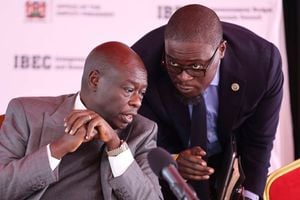70 per cent of Kenyan women not empowered

What you need to know:
- The Kenya Women’s Empowerment Index and the Comprehensive Poverty Report was recently launched by Treasury Cabinet Secretary Mr Ukur Yatani.
- According to the Comprehensive Poverty Report, only 29 per cent of women in Kenya between the ages of 15 and 49 years are empowered.
- The Women Empowerment Index also indicates that women empowerment is slightly higher among households headed by men, at 30 per cent, compared to those headed by women at 28 per cent.
- Among the elderly, 68 per cent of women experience multi-dimensional poverty compared to 48 per cent of their male counterparts.
For decades, women have pushed for equal representation in political leadership, public service among other areas with little or no success. Currently, women’s representation in Parliament stands at 23.3 per cent while at the civil service it is at 43 per cent.
And with the Constitution threshold of mandatory one-third representation of women in appointive or elective bodies, their actual representation often falls short of this requirement.
In the private sector, things are no different.
In a survey of companies listed in the Nairobi Securities Exchange last year, men account for 23 per cent of the board members.
HEALTH SERVICES
Girls in marginalised areas such as North Eastern, Rift Valley and Eastern regions continue to face challenges in accessing education and health services due to poverty and harmful cultural practices.
The Kenya Women’s Empowerment Index and the Comprehensive Poverty Report was recently launched by Treasury Cabinet Secretary Mr Ukur Yatani.
According to the Comprehensive Poverty Report, only 29 per cent of women in Kenya between the ages of 15 and 49 years are empowered.
The findings by the Kenya National Bureau of Statistics (KNBS), which conducted the survey, shows that women in the same age bracket in urban areas are nearly twice as likely to be empowered compared to those in rural areas at 40 to 22 per cent respectively.
The Women Empowerment Index also indicates that women empowerment is slightly higher among households headed by men, at 30 per cent, compared to those headed by women at 28 per cent.
It also shows only six per cent of women belonging to the poorest wealth quintile are empowered compared to those in the richest wealth quintile at 53 per cent.
EDUCATION
Younger women, the index indicates, are more likely to be empowered compared to women aged 40-49 years.
Women in more educated households are more empowered. Ten per cent of women in households where the head whether male or female, has no education are empowered.
This is compared to 39 per cent in households headed by a person with a secondary education and 62 per cent for households in which the head has higher education.
Women with fewer children are more likely to be empowered with 41 per cent of women with no children being empowered compared to 36 per cent, 24 per cent and 13 per cent of women having one to two children, there to four children and five or more children respectively.
UN Women Country director said upon analysing the Comprehensive Poverty Report, 53 per cent of Kenyans experiencing multidimensional poverty today, 65 per cent are women out of which 46 per cent of them aged 18 to 34 are deprived of economic activity while 56 per cent are deprived of education.
Ms Anna Mutavati added that among middle aged, (39 to 54) 76 per cent lack higher education and 81 per cent lack access to the labour market.
ELDERLY WOMEN
The elderly have not been spared either with 68 per cent of elderly women experiencing multi-dimensional poverty compared to 48 per cent of their male counterparts.
On the women empowerment, the UN Women boss said it’s sad to note that 71 per cent of women in the country are disempowered.
“Generation of such gender statistics is critical as it helps us plan better for those who are mostly left behind, an approach known as equity approach to development. If you have limited resources, you prioritise and concentrate them where the biggest four gaps are targeting those most left behind which helps to narrow and close the gaps,” said Ms Mutavati.
It is, however, not all gloom as the index indicates one in every three women countrywide can today participate equally in routine elements of daily economic, social, political, and cultural life, including paid employment, owning land, earning secondary education, making major household decisions, and accessing modern contraception.
GENDER EQUALITY
Public Service and Gender Cabinet Secretary Prof Margret Kobia noted that the country has made commendable progress towards achieving gender equality and women empowerment through development of policies and legislative frameworks enabled by the Constitution.
"The enabling institutional architecture for the realisation of the protection of women’s rights and the affirmative action measures are also firmly anchored on the various international and regional commitments and treaties that Kenya is a signatory to. These obligations are instrumental in tracking and monitoring changes in women's empowerment at both the national and county levels,” said Prof Kobia.
The CS gave notable frameworks as the Sexual Offences Act (2006), National Policy for the Prevention and Response to Gender Based Violence, 2015, Prevention Against Domestic Violence Act (2015), National Policy on Eradication of Female Genital Mutilation (FGM), 2019 and National Policy on Gender and Development (2019).
POLICYMAKING
Mr Yatani said the development of the Women’s Empowerment Index presents a major milestone in the country's evidence-based policymaking and sets a baseline for monitoring of the government's progress toward Sustainable Development Goal 5 on achieving gender equality and empowerment of all women and girls.
“Evidence shows that women and girls continue to be most vulnerable hence the need to increase efforts towards their ability to assert their resilience, versatility and capabilities. Efforts should be made to develop effective and efficient strategies to ensure that the 71 per cent of women disempowered are addressed through better policies and budgets,” said Mr Yatani.
The Chairman of Council of Governors Mr Wycliffe Oparanya said Covid-19 pandemic is deepening pre-existing inequalities, exposing vulnerabilities in social, political and economic systems, which are in turn amplifying the impacts of the pandemic.
COUNTY PROFILES
The Kakamega governor said women’s empowerment is long overdue.
“I am convinced that if gender dimensions and principles are well understood and integrated in all other sectors of development, then our counties will prosper faster and equitably,” said Mr Oparanya.
KNBS Director General Mr Zachary Mwangi said the report will support decision-making for effective and efficient results targeting and utilisation.
He added that the women’s empowerment index provides a baseline for future monitoring of empowerment and development.
Also launched were a series of County Poverty profiles, which are part of the Kenya Comprehensive Poverty Analysis Report detailing the needs of children and women in the 47 counties. They were launched along with 47 County Budget Briefs, which examine how counties are currently spending their money.





